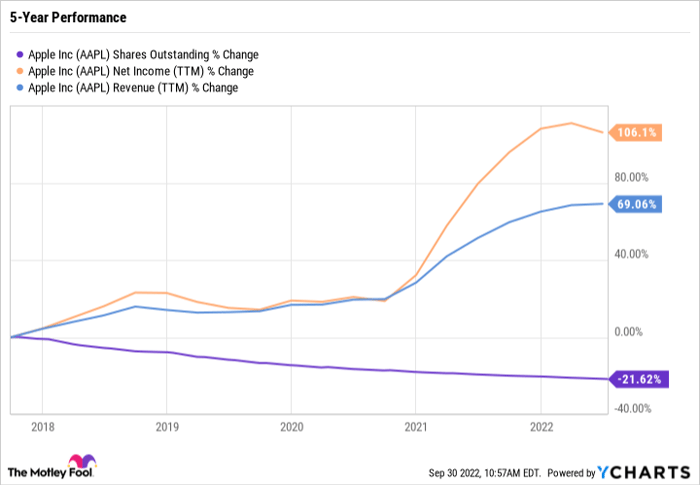This article was originally published on Fool.com. All figures quoted in US dollars unless otherwise stated.
The stock market sell-off has compressed the valuations of good and bad businesses alike. All three major indexes -- the S&P 500, the Dow Jones Industrial Average, and the Nasdaq Composite -- are in a bear market. And while it may be tempting to go bottom fishing by scooping up shares of stocks that are down big off their highs, the safer and potentially more rewarding route is to simply stick with top companies that stand out from the competition.
Investors categorize stocks into buckets -- like growth stocks versus value or dividend stocks. But no matter the size of the company or its industry, there's one key trait that all top stocks share: consistency. Here's why investing in consistent companies can be an excellent strategy for outlasting a prolonged bear market.
Setting expectations
Consistency can take different forms depending on the company. But as a rule of thumb, consistent businesses are those that bridge the gap between expectations, financial goals, and real results.
As a recent example, FedEx's (NYSE: FDX) inability to forecast accurately caused the largest single-day percentage stock decline in company history. The shipping specialist's upbeat tone and record guidance from late June proved to be way off base after it called for lower-than-expected first-half fiscal 2023 results and failed to provide full-year fiscal 2023 guidance.
FedEx has a track record of inconsistency that dates back to the peak of the U.S.-China trade war in 2018, when the company produced lower-than-expected results and routinely missed guidance. FedEx may be an inexpensive stock with a decent dividend yield. And it could even be a nice turnaround play. But it is far less consistent than its peer, United Parcel Service (NYSE: UPS).
UPS has a better track record than FedEx of hitting its financial guidance, navigating challenges, and deploying capital efficiently without overspending. The package delivery industry is cyclical and capital-intensive. UPS and FedEx depend on a blend of business-to-business and business-to-consumer deliveries to domestic and international buyers. Both companies sport incredibly sophisticated supply chains, logistics, and distribution networks. Labor and fuel costs are high, making forecasting an essential quality of a good package delivery company. No one has a crystal ball. But being roughly right when it comes to accurately predicting buyer behavior separates an excellent package delivery company like UPS from an OK one like FedEx.
In sum, the main differentiating factor between these two companies isn't their dividend yields, valuation, or even a year's worth of revenue or earnings. Rather, it is the ability of UPS to better leverage its resources and capital to execute on goals and limit disappointing shareholders.
Delivering on long-term targets
Another core trait of consistent companies is their ability to deliver on long-term targets. For some companies, that could simply mean growing the dividend and supporting it with free cash flow (FCF) or sustaining a high profit margin while growing the top line. For others, it could mean bringing a new product or service to market and increasing customer adoption and retention.
Apple (NASDAQ: AAPL) is an excellent example of a company that has delivered on its long-term targets. It wasn't long ago that investors questioned the feasibility of Apple's wearables, its penetration into wireless earbuds, its ability to continue generating growth from its phones and computers, and the establishment of its services segment. Apple has proven that it has arguably the strongest consumer electronic product ecosystem of any company in the world. Its ability to make new versions of its flagship products while also integrating new products and services into the ecosystem has led to sustained growth, high margins, efficient use of capital, and outsized profits.
Apple has shown that despite its size, it can still grow quickly and drive shareholder value through organic growth and boosting earnings per share through buybacks. The below chart says it all.
AAPL Shares Outstanding data by YCharts
In just five years, Apple has more than doubled its net income and reduced its outstanding share count by a staggering 21.6%. Apple's ability to reinvest capital efficiently in its business and still have plenty of dry powder to buy back its own stock is a testament to the success it has had with hitting its long-term goals of product innovation and vertically integrating its business with both hardware and software. Companies a fraction of the size of Apple tend to have trouble growing profits at a faster rate than revenue. But Apple's ability to drive profits at a faster rate than sales is an example of its pricing power and loyal customer base.
Profiles in consistency
UPS and Apple are just two examples of the many consistent companies that are on sale now. Although they are in different industries and have little in common as companies, they are very similar investments. At the end of the day, long-term investing aims to find companies that can continue delivering growth over time.
For UPS, growth results in a larger dividend, the expansion of routes and services, and branching into new markets such as healthcare and automotive.
In Apple's case, growth results in share buybacks, product development, and expanding its ecosystem to retain existing customers, boost revenue per customer, and attract new customers into the ecosystem.
By understanding what consistency looks like, an investor can put their hard-earned savings to work in quality companies no matter the industry.
This article was originally published on Fool.com. All figures quoted in US dollars unless otherwise stated.










